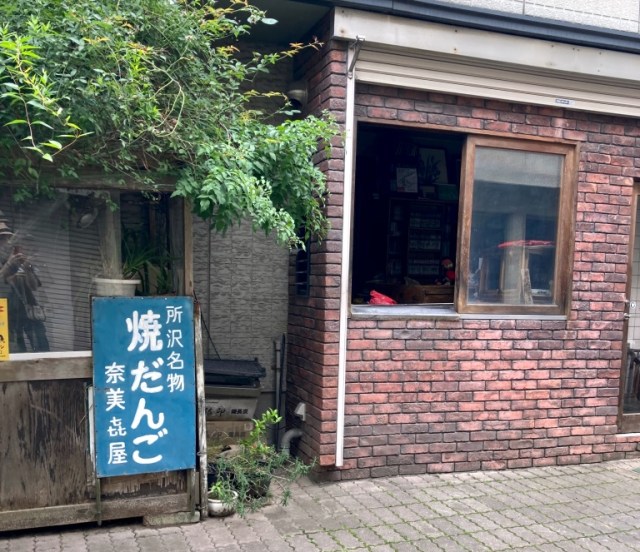
But that one item is all Tokorozawa’s Namikiya needed to win our heart and stomach.
Tokorozawa isn’t a particularly glamorous town. Located in Saitama Prefecture and sitting on the outer edges of the greater Tokyo area, it’s pretty far from the big-name attractions of the capital, yet not yet far enough into the countryside to be a major outdoor leisure destination.
But some of the best parts of being in Japan are the discoveries you make on the sleepy side streets of its more tranquil neighborhoods, and that brings us to Namikiya.
The simple brick storefront, built into the first floor of a house, is rustically charming, but doesn’t do all that much to catch the eye. We might have walked right on by, except that we noticed the blue sign with “Namikiya – Tokorozawa’s Famous Yakidango” written on it.
▼ This sign
Yakidango is a combination of dango, Japanese dumplings, and yaki, which in this case means “grilled.” Skewered and slathered in a salty sweet glaze, yakidango have been a beloved snack for generations, and Namikiya makes theirs from scratch, according to another sign which also lists their price, just 110 yen (US$0.80) per skewer, and yakidango are the one and only thing Namikiya sells.
There’s a minimum order size of five skewers, but still, that’s a bargain. We walked up to the counter and asked for five, but the owner, Namiki-san, didn’t hand us a pack of pre-cooked dumplings. The shop doesn’t grill our dango until you order them, to ensure they’re as soft and flavorful as they can be.
With our order placed, Namiki-san produced a piece of charcoal, placed it underneath the grill, and lit it, using the breeze from an electric fan to help get the fire going. He then placed five dango skewers on the grill, periodically rotating them with his dexterous fingers as they cooked and fanning the flames with an uchiwa fan that he held in his other hand.
Once they were suitably grilled, he plucked the skewers off the grill and gave them each a few dunks into a container of the soy sauce-based glaze, placed them on a strip of kyogi (wood sliced to a paper-like thinness), wrapped up the package, and handed the freshly cooked treats to us.
▼ With four bite-sized dango to a skewer, the minimum order gives you a total of 20.
Speaking of the wrapping, on the inside is a retro illustration of a dango chef hard at work,
The line of text at the very bottom of the paper says “Dedicated to yakidango for 65 years.” “Wow, so Namikiya has been in business since 1958?” we asked Namiki-san, who surprised us by replying “Oh, we did the design for that paper a while ago. We’ve been in business for about 70 years now.”
“I took over the business from my dad,” he explained. “For the first 50 years, our shop was over near where the Tocotoco Square Tokorozawa [shopping center] is, and then we relocated to this spot 20 years ago.”
We also learned a bit more about why Namikiya’s sign says Tokorozawa is known for its yakidango. Back in the old days, farmers were having trouble making flooded rice paddies in the area, so they switched to raising varieties of rice that can be grown on dry land. When steamed, the flavor wasn’t considered to be on par with grown-in-paddies varieties, but Tokorozawa’s rice tasted just fine when it was made into rice flour dumplings and roasted. These days, a lot of the old yakidango shops in the area have closed down for good, but Namikiya is still surviving.
As for how Namikiya’s dango taste, they’re great. The flavor balance is more towards the salty than the sweet, but both sensations are present, so they’re a snack that just about anyone can enjoy, and also afford, given their very low price. And as a locally made traditional Japanese sweet, they’re arguably the perfect thing to pick up before or after visiting the nearby “Totoro Forest,” the real-world woodlands that inspired the setting of the Studio Ghibli anime classic.
Speaking of prices, we asked Namiki-san if the rising costs of ingredients in Japan’s increasingly inflationary economy was making it hard for him to do business, and if he feels like he’ll soon have to start charging customers more, to which he replied:
“Nope, not really. As long as we can earn enough to keep the shop going, that’s enough.”
The response was simple, soothing, and warm, just like the dango Namikiya makes.
Shop information
Namikiya / 奈美喜屋
Address: Saitama-ken, Tokorozawa-shi, Miyuki-cho 6-5
埼玉県所沢市御幸町6-5
Open 10 a.m.-6 p.m.
Photos ©SoraNews24
● Want to hear about SoraNews24’s latest articles as soon as they’re published? Follow us on Facebook and Twitter!